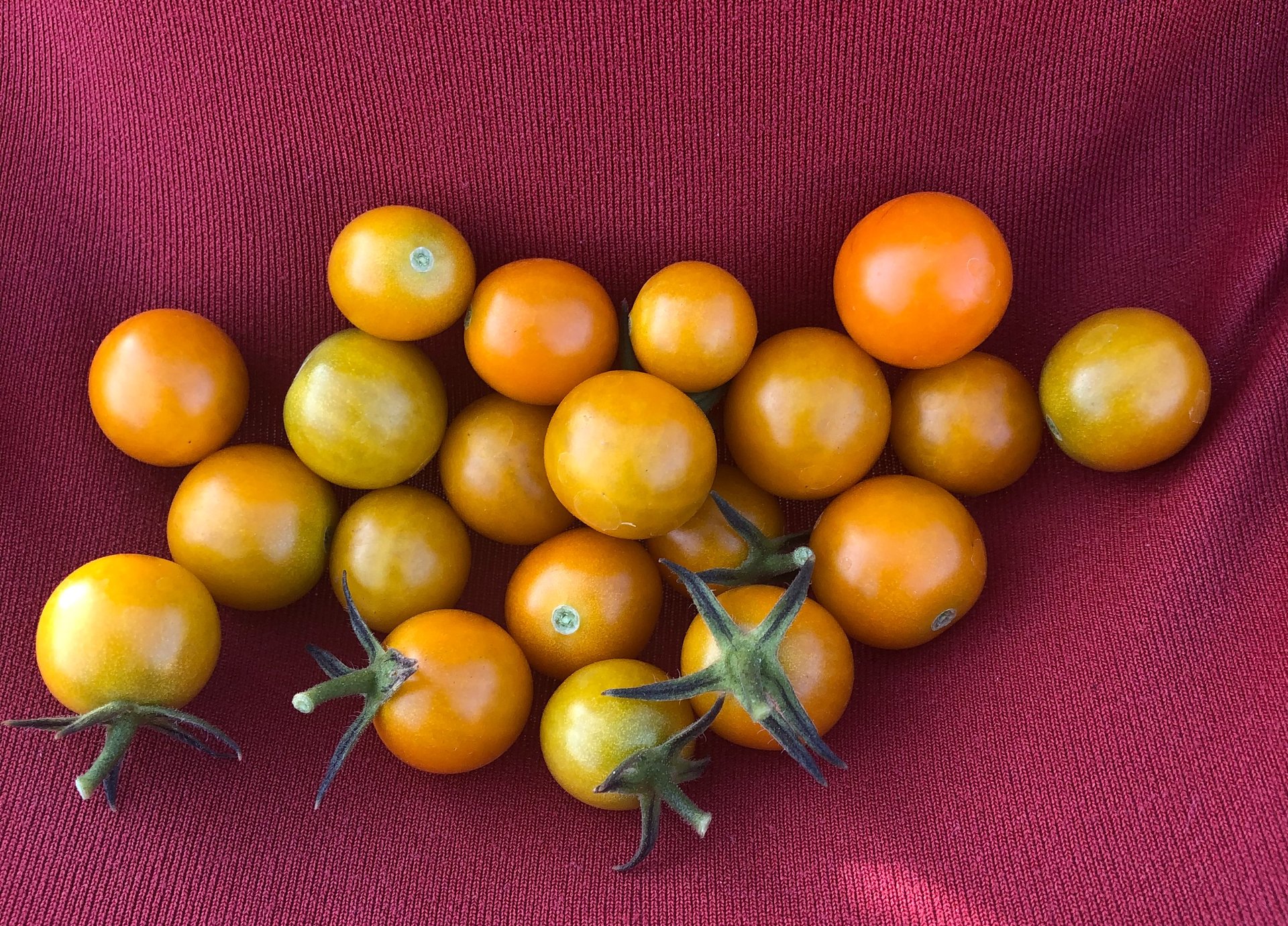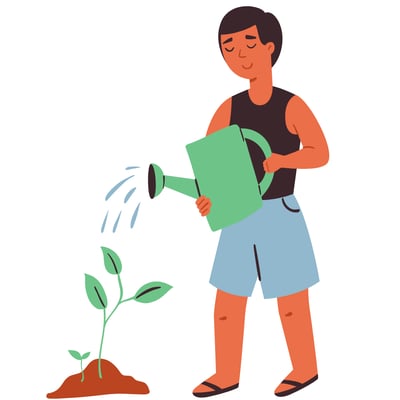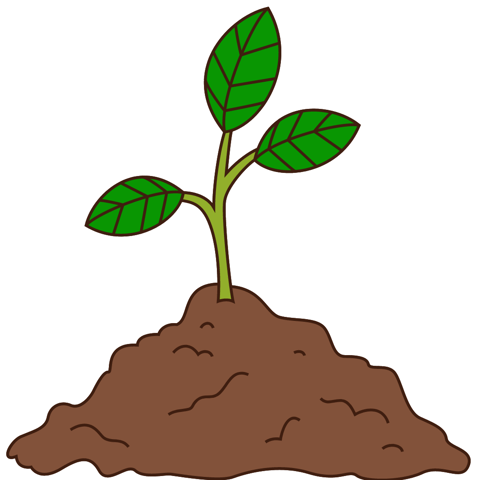
5 Tips to Grow Food & Plants Anywhere
5 tips that will help get started and kickstart your growing goals.
PLANTS
Kylie Treekin
4/15/20248 min read
I hear a lot of people talk about how difficult it is to grow food, and the "black thumb" syndrome. In my experience, it's just that you haven't found the right plants for the space, or learned the particular needs of that plant. Once you know those 2 things, you really can grow food anywhere. I wanted to put together some tips that might inspire you to grow more food in your space, no matter your location.
So pull up a pot, get your hands on some dirt, and use the resources here to help you get growing!


5. Slow & Steady Wins The Race
Another big mistake I've made along with countless others, is trying to grow too many “new to me” plants at one time. They will have a variety of needs and trying to pay attention to all of their signs while also learning what they need can be difficult. Start with plants that like to grow well together, as mentioned before helps a lot with the success of multiple new plants. If you have a problem, don't get discouraged; become the master of that one plant, or move along to another one. Either way, you will have much more success when you focus on a couple of new things at a time versus getting ALL of the plants.
4. Create the other conditions the plant needs.
Putting Plants in Soil
Cactus and succulents need very different soil from a tropical indoor plant and they both need different soil than an in-ground garden, raised bed or pot. Most plants that have special needs will say so on the tag description or seed pack so keep an eye out for that.
If you're buying bagged dirt there are 2 things to look for, what is in the blend of soil and what the soil's recommended use is. For example, if you are filling a raised bed, buy raised bed mix, if you're filling a pot, buy potting soil. Then there are specialty soils for things like cacti, roses, and compost blends for top-dressing nutrients on existing plants. If you are filling a large raised bed, or need to bring in large amounts of dirt to your property, search for "landscaping supply" on Google Maps. Landscaping supply companies will usually make bulk deliveries to home addresses as well. They should also be able to help you determine the quantity of soil you'll need and recommend a blend for your purposes.
If you can help it, never leave the soil exposed on any pot, raised bed, and especially in-ground plants, read more about this in our soil degradation post. The sun will suck out the nutrients from the soil along with increasing water evaporation. You want mulch to be at least 1 inch and up to 3 inches thick leaving a circle around the stem or trunk of the plant to prevent rotting & disease. Another reason to mulch is to give the bugs something to do other than attack your freshly planted treasures. In hot or dry climates it's even more important to mulch because the sun can be so powerful it turns the soil into a compacted brick. Here are a couple of different ideas for generating free mulch or what to look for if you purchase.
3. Choose Plants Based On Light Availability
If you were anything like me when I first got excited about growing plants, you just buy the ones that look cool when you happen to see them. This is one of the biggest reasons plants don't make it. Every plant has a different need for light, soil, water, nutrients, and even season, so when one isn't met...well, I think we all know what happens. The best way to avoid this is to start out by choosing plants that you know you have the sun conditions for because it's the hardest resource for humans to control. You have already completed step one and found the sun and know how to read seed packets so now its time to shop! Most seed packets and store-bought plants will have a tab or section indicating how much sun they need or you can find the description online for a specific plant you might be eyeballing.
If you are gardening and trying to grow food, I always recommend to people starting out to pick a couple of the plants that work together from this great Companion Planting guide from Permaculture News. By starting out with plants you know will work well together, you will already be ahead of the curve! Vegetables also have certain times of the year that they thrive, for example, you can grow Brassicas in summer in Texas but it's really difficult because pests are high and they need some sort of sun protection from a taller plant or shade cloth. Texas A&M has a pretty good guide for when to plant what in Central Texas, but if you find pests are too great, move to something else instead of fighting an uphill battle.
2. Understand the Lingo
Sometimes reading labels of plants can be a little confusing, so here's a quick little guide on what all of those terms mean. You will need to understand these for the next step where you pick out seeds!
Annual - A plant that grows from seed and dies after blooming.
Perennial - A plant that generally lives for 3-5 years.
Full Sun - Gets sun most of the day.
Part Sun - Gets morning sun or has some direct sunlight throughout the day.
Low Sun - Needs to be planted in the shade but still needs plenty of indirect sunlight.
Low Light or Shade Plants - Indirect sun makes them happy.
Heirloom - Refers to the heritage of the plant, usually protected from cross-breeding.
Organic - Means no pesticides or only organic pesticides were used during the growing process.
Non-GMO - This means the seeds have not been genetically modified, most GMOs are commercial only, Non-GMO is a marketing ploy.
Cross-pollination- means this plant requires another one of its kind to produce fruit or seeds.
Open pollination- This plant can pollinate itself and does not need pollination from another.
Hybrid - means it's been crossbred to produce disease resistance or a certain color, etc.
Zone - Refers to the climate zone you are in based on location, check yours here.
1. Find the Sun
The first thing you want to look for when you begin finding and choosing a spot to grow, is what kind of lighting you have access to.
Notice where the sun shines throughout the whole day and how many hours it gets. The morning sun is preferred by a lot of plants, especially in hotter climates where evening sun can be so strong it becomes damaging.
Make a mental note of which windows in your house or apartment get access to the sun as it moves along its daily path.
Keep in mind that the sun will be higher across the sky in Summer and lower in Winter which will slightly change the sun you get as the seasons change.
If you have large trees with dappled light, try to notice when certain spots seem to get more sun in the day, that will be the best spot to grow.
If you have very little to almost no sunlight entering your home, I highly recommend purchasing a lamp with movable heads to place grow lights in. Grow lights can be found in hydroponic specialty stores and your local hardware box store like these.
If getting a grow light is not really an option for you right now, don't fret! There are still some plants that love low light believe it or not!
Leaves - are free! Even if you don't have trees, driving around a neighborhood after a weekend is most likely to yield you free leaves or yard clippings. The only thing to be cautious of is dog poop that people may have also scooped up from their yard.
Free shredded wood - can be obtained by calling around to local tree trimming companies. They may have a waiting list, but once it's your turn they will bring you a free load of shredded wood mulch from their daily jobs and leave it in your driveway. They have to pay to trash it or recycle it so you are saving them money and the environment from unnecessary trash.
Bagged shredded wood mulch - this is the fanciest stuff and has usually already been through a composting process which can give it a variety of colors. Some yucky brands add dye so look for the natural stuff or a local company that makes their own product. This kind of mulch provides a clean beautiful look. You can also check landscaping supply companies for bulk mulch pricing.
Watering
Watering is going to be very different for different types of plants. Read the plant labels for instructions on how to water. If it says that the soil needs to dry all the way first, try the thumb test. Stick your finger in the soil, if it's dry it needs watering, if it's moist and sticks to your finger, leave it alone. Frequently plants are over-watered because people are paying way more attention to them than they need. My houseplant rule of thumb is if it can't handle my once-a-week watering habit, I probably don't need it because I won't remember to water more than that. Things like fruits and veggies need a lot more water, which includes some indoor tropical plants as well. I like to set up irrigation for fruit trees because if some varieties don't get enough water the fruit tastes terrible or won't grow and I don't water more than every 2-3 days (more in high summer in TX.) Vegetable seedlings need watering every day at first then every other day once they have the first set of true leaves. The first set of leaves from a seed sprout are always different than the actual leaf it makes as an adult plant.
In general, the biggest tip I have for watering is pay attention to the soil, it should never be sopping wet for too long nor too dry for too long. Observation takes time and practice, but don't give up!
Nutrients
Soil does not continue to hold nutrients forever, you will have to apply nutrients to keep the microbes happy and the nutrient content balanced and plentiful. The best way to do this is to start a compost or vermiculture bin. Once to twice a year depending on the plant (again labels should say unusual or high maintenance needs) you will need to add some organic fertilizer back into the soil. In a forest, the leaves fall and get composted by the forest floor animals and turned back into dirt, but compost turns scraps into dirt much easier in 1-6 months depending on the method. There are also some good sea kelp sprays or other organic fertilizers you can buy for seasonal fertilization that can help plants get through an explosion-growing season. Some plants like tomatoes, suck up a lot of nutrients and produce even better with a little extra love. Again reading up on the specific plants you are growing will help you determine what kinds and how frequently you need to add to your soil.
With my standard twice-yearly practice of adding compost from my household bin, I find that adding a seaweed fertilizer once a month in the peak of my growing seasons helps everything stay big, beautiful, and abundant. Plants that have all their nutrient needs met are also more resilient to things that could shock them, like swings in temperature.


HAPPY GROWING YA'LL!


